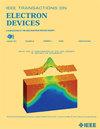增强间接飞行时间传感器解调对比度的扩展光电二极管方案
IF 3.2
2区 工程技术
Q2 ENGINEERING, ELECTRICAL & ELECTRONIC
引用次数: 0
摘要
近年来,间接飞行时间(iToF)传感器利用背侧结构技术(BST)通过增加对红外光的吸收来提高量子效率。然而,该技术导致电子在远离像素中心的地方产生,由于电荷转移效率低下,导致解调对比度(DC)下降。本研究首次深入分析了电子生成的空间分布如何影响iToF传感器中的直流电,使用TCAD模拟,分析了电子传递比和光生成曲线。我们引入了转移对比度(TrC)的概念,定义为电子到存储节点的转移比(MNs),并将其与光产生的概率结合起来研究,以量化局部电荷转移低效。为了解决性能下降的问题,我们提出了一种扩展的光电二极管方案,具有垂直和横向扩展。该设计通过在像素区域引入额外的电场来加速在像素边缘产生的电子,确保在脉冲时间内有效地将电荷传输到MN。该方案提高了12%的直流电,降低了18%的寄生光灵敏度(PLS),并具有最小的制造复杂性。这种方法与各种像素尺寸兼容,并为红外成像应用提供了更高的深度精度。本文章由计算机程序翻译,如有差异,请以英文原文为准。
Extended Photodiode Scheme for Enhancement of Demodulation Contrast in Indirect Time-of-Flight Sensors
Recent indirect time-of-flight (iToF) sensors utilize backside structure technology (BST) to improve quantum efficiency by increasing the absorption of infrared light. However, this technology causes electrons to be generated far from the pixel center, leading to degraded demodulation contrast (DC) due to inefficient charge transfer. This study presents the first in-depth analysis of how the spatial distribution of electron generation affects DC in iToF sensors using TCAD simulations, analyzing both electron transfer ratios and optical generation profiles. We introduce the concept of transfer contrast (TrC), defined as the electron transfer ratio to the memory nodes (MNs), and examine it in conjunction with the probability of optical generation to quantify localized charge transfer inefficiencies. To address the performance degradation, we propose an extended photodiode scheme with vertical and lateral expansion. This design accelerates electrons generated even at the edges of the pixel by introducing additional electric fields across the pixel region, ensuring efficient charge transport to the MN within the pulse time. The proposed scheme enhances DC by 12% and reduces parasitic light sensitivity (PLS) by 18%, with minimal fabrication complexity. This approach is compatible with various pixel sizes and offers improved depth accuracy for infrared imaging applications.
求助全文
通过发布文献求助,成功后即可免费获取论文全文。
去求助
来源期刊

IEEE Transactions on Electron Devices
工程技术-工程:电子与电气
CiteScore
5.80
自引率
16.10%
发文量
937
审稿时长
3.8 months
期刊介绍:
IEEE Transactions on Electron Devices publishes original and significant contributions relating to the theory, modeling, design, performance and reliability of electron and ion integrated circuit devices and interconnects, involving insulators, metals, organic materials, micro-plasmas, semiconductors, quantum-effect structures, vacuum devices, and emerging materials with applications in bioelectronics, biomedical electronics, computation, communications, displays, microelectromechanics, imaging, micro-actuators, nanoelectronics, optoelectronics, photovoltaics, power ICs and micro-sensors. Tutorial and review papers on these subjects are also published and occasional special issues appear to present a collection of papers which treat particular areas in more depth and breadth.
 求助内容:
求助内容: 应助结果提醒方式:
应助结果提醒方式:


